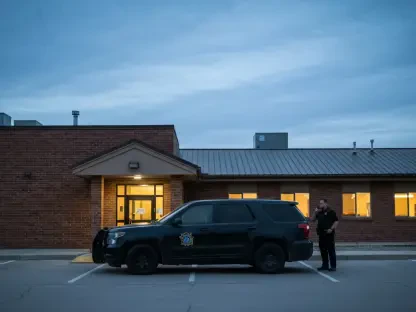The question of whether imposing buffer zones around courts infringes upon free speech rights has gained significant attention as a First Amendment challenge unfolds in a Massachusetts court. The challenge has arisen in response to a 200-foot buffer zone implemented outside the Norfolk Superior Court during the retrial of Karen Read, accused of second-degree murder. This judicial order has spurred controversy, igniting debates on its breadth and vagueness as a restriction. Those challenging the measure, including four demonstrators who previously protested the trial process, assert the buffer zone unlawfully suppresses their right to free speech. The case has drawn the attention of Judge William Kayatta of the U.S. Court of Appeals for the First Circuit, who voiced apprehensions regarding potential constitutional overreach as it relates to the right to protest at this controversial venue. This unfolding legal drama raises pivotal questions about the relationship between law enforcement and the exercise of free speech in public spaces, particularly during high-profile trials. The conversation pivots around the struggle to maintain a balance between upholding courtroom integrity and protecting the citizens’ right to express dissent.
Balancing Judicial Integrity and Civil Liberties
One of the core issues driving the current legal dispute involves navigating the delicate equilibrium between maintaining the sanctity of judicial proceedings and defending demonstrators’ constitutional liberties. Ensuring that high-profile court cases remain undisturbed by external influences is paramount, yet this must be achieved without infringing on peaceful protestors’ abilities to voice their discontent. As widespread public interest in Karen Read’s retrial persists, the ramifications of the buffer zone’s legal challenge set the stage for potential precedents concerning demonstrative rights in proximity to court premises. Adhering to founding principles, judicial establishments must find ways to safeguard processes that diminish external disruptions while facilitating citizens’ ability to influence society through lawful protests. Establishing clear, unambiguous guidelines helps in both reducing judicial distractions and averting unwarranted constraints on civil liberties. This case serves as a microcosm for wider national dialogues over how judicial spaces regulate public expression, posing crucial questions on the boundaries of necessary versus excessive restrictions.
The debate surrounding buffer zones is not confined to just legal texts; it draws upon the broader social and political contexts that affect American democratic practices. Previous discourse on similar issues has prompted lawmakers and legal experts to explore regulatory practices, aligning them more closely with constitutional mandates. Numerous courts across the country have grappled with striking reasonable balances, suggesting the potential necessity for refined legal frameworks or legislative action—such as enacting clearer legislation that delineates boundaries of permissible protest activities. Illustratively, as legal minds and social commentators weigh in, the resonance of this litigation echoes widely in educational circles, public forums, and policy-making discussions, reinforcing the universally recognized importance of protecting free speech rights. In acknowledging this ongoing struggle, it becomes critical to advance conversations that apply consistent and coherent methodologies in reconciling security with liberty, potentially informing future judicial perspectives nationwide.
The Continuing Debate on Public Demonstration Rights
Enmeshed within this legal discourse is a deeper, enduring debate on buffer zones’ broader impacts on public demonstration rights. The present judicial inquiry, while ostensibly centered on the particulars of the buffer zone surrounding the Norfolk Superior Court, invariably touches upon reflections on boundary establishments’ roles across varying contexts—whether concerning reproductive health clinics, polling stations, or other public arenas. Here, buffer zones are endemic to issues surrounding protest rights, evoking strong sentiments on either side of the discussion. From a historical viewpoint, demonstration activities near sensitive centers often prompt concerns over misconduct potential, resulting in choices that improperly limit lawful assemblies to ensure public order. However, critics argue against the imposition of broad buffer areas, signaling that excessive restrictions betray fundamental rights and disenfranchise constituencies. There’s certainly an underlying need to address the complex interplay between spatial demarcations and the inherent freedoms afforded to citizens.
While this ongoing legal battle will yield specific verdicts concerning the challenged buffer zone, its resolutions ripple widely through societal concepts on rights and responsibilities in public discourse. By scrutinizing how such zones are justified and implemented, the ruling will either reinforce existing practices or catalyze reform efforts aimed at recalibrating established standards to better respect constitutional guarantees. The profound stakes inherent in this dispute underscore the magnitude of its outcomes and their implications for citizens’ relationships to governmental authority and public stewardship of shared democratic principles. Through measured judgments in challenging buffer zones, pathways are opened to meaningful and sustainable approaches, ensuring justice systems and public assemblies coexist compatibly without incurring undue harm to civil principles.
Future Implications and Legal Precedents
The question of whether creating buffer zones around courts infringes on free speech rights has garnered considerable attention as a First Amendment challenge unfolds in a Massachusetts court. This issue arose from a 200-foot buffer zone established outside Norfolk Superior Court during the retrial of Karen Read, who faces charges of second-degree murder. The order has sparked controversy due to its perceived breadth and vagueness. Critics, including four protesters unhappy with the trial proceedings, claim the buffer zone unlawfully suppresses their free speech rights. Judge William Kayatta of the U.S. Court of Appeals for the First Circuit has expressed concerns about the possible constitutional overreach, particularly regarding the right to protest at contested sites. This unfolding legal scenario raises critical questions about the dynamic between law enforcement and the exercise of free speech in public spaces amid high-stakes trials, focusing on balancing courtroom integrity with citizens’ rights to voice dissent.









